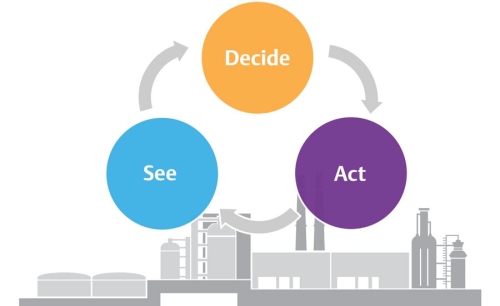Pneumatic systems power many processes in processing and packaging lines. However, if they run unchecked, compressed air leaks can develop and inefficient processes can use more energy than they require.
This usually happens when manufacturers don’t have access to detailed, local data about how much compressed air their machines or lines use. To improve process efficiency, reduce energy costs and operate packaging and processing lines more sustainably, companies of all sizes have started monitoring compressed air consumption.
Some manufacturers have integrated digital technologies that unlock pneumatic data across the factory floor, then translate it into valuable insights that scale in the cloud. Together, these technologies are available as part of a pre-engineered compressed air monitoring cabinet solution that provides detailed, real-time analysis of how compressed air consumption behaves and is simple to install, commission and deploy.
In this way, a compressed air monitoring cabinet makes it possible for companies to quickly and easily gain visibility into actual energy use and better control consumption, with resolution that can scale from individual machines to lines, from a single factory to multiple plants. By continually monitoring pneumatic systems in real time, operators can detect anomalies that lead to leakage losses, as well as improve process efficiency by balancing pneumatic devices and automating manual tasks.

Compressed air monitoring technologies utilize the See, Decide, Act cycle to automate or digitize leak detection. (Image courtesy of Emerson).
Save Energy By Detecting Early-Stage Leakage
Access to real-time pneumatic data makes it possible for manufacturers to make informed decisions and take meaningful action that can continually improve process efficiency and sustainability. Compressed air generation makes up about 20% to 30% of a typical manufacturing facility’s electricity consumption. Without compressed air monitoring, up to 30% of the compressed air generated goes to waste. This waste occurs for several reasons, including leaks caused by failures at joints and tubes, exposure to vibration and normal component wear, and the suboptimization of machines and devices.
Continuous monitoring capabilities allow operators to detect leaks and other anomalies in their early stages. By addressing pneumatic issues before they can grow, companies can reduce compressed air use by 20% to 30%.
Companies can use the following formula to calculate potential energy savings:
A = Yearly or monthly energy costs
A X 30% = B (Compressed air energy cost)
B X 25% = C (Wasted energy cost)
C X 25% = D (Monthly/yearly savings)
D = Potential savings delivered
For example, a company that spends $1 million per year on energy costs could save up to $18,000 annually.
Here’s how early-stage leak detection works. Compressed air monitoring uses technologies that automate or digitize each step of a continuous loop called the See, Decide, Act cycle.
During the See stage, smart airflow sensors measure values such as flow, pressure, temperature and with smart software applications, such as the Compressed Air Manager App from Emerson, carbon dioxide generation and energy can be analyzed and calculated.
During the Decide stage, the sensors send collected data to an edge gateway that continuously aggregates and transmits the data to analytics software. The software contextualizes and presents the flow sensor data as statistics and trends, providing insight into current and historical consumption. In addition, the recorded data generates detailed analyses that provide information on energy consumption and the amount of carbon dioxide produced, as well as calculates the machine's idle time. This value shows the percentage of time compressed air is being used even though the machine is stopped. Operators can use this information to make quick decisions and take the most appropriate action.
During the Act stage, the analytics software can share the information it collects with various other platforms, such as HMI/SCADA solutions or manufacturing execution systems (MES), using a standardized connector. Operators and maintenance teams can use this information to reduce machine downtime, schedule maintenance calls to repair leaks, and optimize compressed air consumption.

Compressed air monitoring can help companies overcome common pneumatic system challenges, including inefficient use of air, leakage and high maintenance costs. (Image courtesy of Emerson).
Improve Process Efficiency Through Automation And Pneumatic Balancing
Continuous compressed air monitoring can also help manufacturers significantly reduce maintenance costs, decrease unplanned downtime by 20% and improve overall equipment effectiveness (OEE) by 5% to 10%.
On average, 76% of companies manually test for compressed air leaks across their facilities. This often requires a third-party service or experienced internal personnel to check every machine. These periodic audits can cost an average of $46,000 per machine per year due to service, equipment, training investments, and leaks have time to develop and grow between them.
In comparison, compressed air monitoring can continuously measure airflow in real time, identify anomalies in their early stages and send personnel notifications to address them. With around-the-clock access to pneumatic system health, operators can track parameters that deviate from baseline values, investigate possible issues, plan maintenance and quickly address potential issues before they can become big problems. In this way, automated detection can save companies a significant amount of time and maintenance costs compared to manual audits, as well as minimize failures and the downtime that results.
By addressing potential issues as they arise, companies can increase machine availability and, in turn, overall equipment effectiveness (OEE) values. On average, most packaging equipment typically operates at around 65% OEE. This means there’s a lot of potential for improvement and greater productivity. One way to do this is by using compressed air monitoring to balance pneumatic devices, such as actuators.
Each pneumatic device has an optimal ratio of airflow to pressure. When this ratio is just right, processes run on effectively and efficiently. If devices receive too much airflow, processes waste energy. If devices receive too little airflow, processes run ineffectively and product quality may suffer. Using data received from compressed air monitoring, operators can appropriately balance pneumatic devices.

The cabinet solution from Emerson includes AVENTICS AF2 airflow sensors, a PACSystems edge gateway and a SolaHD industrial power supply. (Image courtesy of Emerson).
Start Monitoring Compressed Air Quickly And Easily
Innovations in digital technology make it simpler than ever for manufacturers to start monitoring pneumatic systems. Instead of piecing together sensors and software from various vendors and engineering a larger system on their own, companies can source a single, integrated solution.
Compressed air monitoring cabinets are preengineered, installation-ready packages that are fully assembled and include all hardware and connected software. This makes them easy to set up, configure and quickly deploy. Multiple smart airflow sensors can be directly connected, configured and put into operation just as simply, making the solution highly scalable as well.
At Emerson, we took a Floor to CloudTM approach to develop our cabinet solution. The solution includes our AVENTICSTM AF2 airflow sensors, which collect pneumatic data across the factory floor, as well as a PACSystems edge gateway and advanced software that translate data into valuable insights that scale in the cloud. Once the edge gateway collects, processes and validates data, generated information and insights can be pushed to leading systems, such as MES, HMI/SCADA solutions via appropriate interfaces, such as OPC UA.
The cabinet solution also includes a SolaHD industrial power supply for stable and secure power for the individual components, as well as a power-over-Ethernet (PoE) switch that supplies power to smart airflow sensors via the existing Ethernet cable.
The core element of compressed air monitoring is the software application it uses. With OPC UA, the Compressed Air Manager App from Emerson offers a standardized interface known industrywide, with which data can be exchanged with third-party systems. The app comes pre-installed on the edge gateway, seamlessly connects with AF2 flow sensors and provides automatic parameterization and configuration. Its centralized dashboard displays both individual machine air consumption and total air consumption across a line or entire facility. Users can see key performance indicators (KPIs) and metrics such as air flow, pressure, energy cost and CO2 emissions as well as machine idle time and compressed air consumption when machines are not in use.
By using the Compressed Air Manager App, users can directly access and control connected AF2 flow sensors from wherever they are. This makes it possible for companies to continuously monitor air consumption data, trends and costs from the individual machine level up to the complete line or facility and empower teams with in-the-moment insights that drive continuous improvement. In this way, companies can increase energy savings, reach sustainability initiatives and reduce maintenance intensity and air audits. As the app continues to evolve, users will benefit from future updates, as well as current features.
Greater Visibility For Greater Outcomes
Integrated cabinet solutions make taking the first step to monitoring compressed air faster and simpler than ever before. A complete control cabinet solution offers companies a ready-to-use solution that can be put into operation easily and quickly without much additional effort, especially with typical factors like power supply, switch wiring, ingress protection (IP) enclosure and software installation and setup already taken care of.
By monitoring compressed air, manufacturers can gain greater visibility and obtain insights and actionable information that can improve process efficiency, reduce energy costs and, as a result, achieve greater sustainability and productivity.
|
|
Hendrik Priemer, Product Manager, Intelligent Automation, Emerson |
About the Author
Hendrik Priemer serves as a Product Manager specializing in Industrial Internet of Things (IIoT) applications within the field of Machine Automation. In his role, he oversees the execution of new product development initiatives and holds worldwide accountability for advancing the IIoT Strategy pertaining to hardware and software solutions designed for Machine Automation. His collaborative endeavors contribute significantly to the creation of cutting-edge products engineered to elevate the intelligence and sustainability of solutions brought to the market.
For more information visit Emerson at https://www.emerson.com/global.
To read similar Pneumatics and Instrument Technology articles, please visit https://www.airbestpractices.com/technology/instrumentation
Visit our Webinar Archives to listen to expert presentations on Compressed Air Measurement and Monitoring at https://www.airbestpractices.com/webinars.
Published April 2024.





